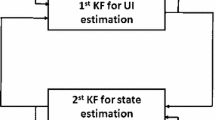Abstract
The Kalman filter for linear systems with colored measurement noises is revisited. Besides two well-known approaches, i.e., Bryson’s and Petovello’s, another measurement time difference-based approach is introduced. This approach is easy to be implemented and generalized to nonlinear system, and can provide filtering solutions directly. A unified view on these approaches is provided, and the equivalence between any two of the three is proved. In the case study part it is validated that, compared to the approach that neglects the time correlations, the approaches that take them into account not only avoid overly optimistically evaluating the estimate, but also improve the transient accuracy of the estimate.





Similar content being viewed by others
References
Bryson A, Henrikson L (1968) Estimation using sampled data containing sequentially correlated noise. J Spacecr Rockets 5:662–665
Bryson A, Johansen D (1965) Linear filtering for time-varying systems using measurements containing colored noise. IEEE Trans Autom Control 10:4–10
Chang G (2014a) Comment on “A Gaussian approximation recursive filter for nonlinear systems with correlated noises”. Automatica 50:655–656
Chang G (2014b) Marginal unscented Kalman filter for cross-correlated process and observation noise at the same epoch. IET Radar Sonar Navig 8:54–64
Chang S-Y, Mills G, Latif S (2012) Application of Kalman filter with time-correlated measurement errors in subsurface contaminant transport modeling. J Environ Eng 138:771–779
Ding W, Wang J (2011) Precise velocity estimation with a stand-alone GPS receiver. J Navig 64:311–325
El-Rabbany A, Kleusberg A (2003) Effect of temporal physical correlation on accuracy estimation in GPS relative positioning. J Surv Eng 129:28–32
Han S, Wang J (2012) Integrated GPS/INS navigation system with dual-rate Kalman Filter. GPS Solut 16:389–404
Howind J, Kutterer H, Heck B (1999) Impact of temporal correlations on GPS-derived relative point positions. J Geodesy 73:246–258
Kim D-M, Suk J (2012) GPS output signal processing considering both correlated/white measurement noise for optimal navigation filtering. Int J Aeronaut Space Sci 13:499–506
Lambert HC (2012) Cramer-Rao bounds for target tracking problems involving colored measurement noise. IEEE Trans Aerosp Electron Syst 48:620–636
Luo X (2013) GPS stochastic modelling: signal quality measures and ARMA processes. Springer, Berlin Heidelberg
Miller C, O’Keefe K, Gao Y (2012) Time correlation in GNSS positioning over short baselines. J Surv Eng 138:17–24
Niu X, Chen Q, Zhang Q, Zhang H, Niu J, Chen K, Shi C, Liu J (2014) Using Allan variance to analyze the error characteristics of GNSS positioning. GPS Solut 18:231–242
Odolinski R (2012) Temporal correlation for network RTK positioning. GPS Solut 16:147–155
Petovello MG, O’Keefe K, Lachapelle G, Cannon ME (2009) Consideration of time-correlated errors in a Kalman filter applicable to GNSS. J Geodesy 83:51–56
Petovello MG, O’Keefe K, Lachapelle G, Cannon ME (2011) Erratum to: consideration of time-correlated errors in a Kalman filter applicable to GNSS. J Geodesy 85:367–368
van Graas F, Soloviev A (2004) Precise velocity estimation using a stand-alone GPS receiver. Navigation 51:283–292
Wang J, Satirapod C, Rizos C (2002) Stochastic assessment of GPS carrier phase measurements for precise static relative positioning. J Geodesy 76:95–104
Wang K, Li Y, Rizos C (2012) Practical approaches to Kalman filtering with time-correlated measurement errors. IEEE Trans Aerosp Electron Syst 48:1669–1681
Wang X, Liang Y, Pan Q, Zhao C, Li H (2012) Unscented Kalman filter for nonlinear systems with colored measurement noise. Acta Automatica Sinica 38:986–998
Wu W-R, Chang D-C (1996) Maneuvering target tracking with colored noise. IEEE Trans Aerosp Electron Syst 32:1311–1320
Acknowledgments
The author’s sincere thanks go to the associate editor and three anonymous reviewers for their thorough and critical comments which improved the ealier draft significantly; and also to Dr. Jiaxun Li of Tianjin Institute of Hydrographic Surveying and Charting, and Dr. Lubin Chang of the Department of Navigation Engineering, Naval University of Engineering, for checking the English. This work was supported in part by National Natural Science Foundation of China (No. 41374018).
Author information
Authors and Affiliations
Corresponding author
Appendix: proof of (48)
Appendix: proof of (48)
Substitute (27), (43), and (45) into (42) we have
Substitute (10) into \(F\varvec{K}_{(1)} {\varvec{\varSigma }}_{(1)} \varvec{J}^{T}\) and \(\varvec{J}{\varvec{\varSigma }}_{(1)} {\varvec{K}}_{(1)}^T {\varvec{F}}^{T}\), (8) into \(J\varvec{\varSigma }_{(1)} \varvec{J}^{T}\), with (18) in mind, (60) can be rearranged as
With (15) in mind we notice that
and its transpose
So with (15) in mind, we have
Substitute (64) into (61), we have
Rights and permissions
About this article
Cite this article
Chang, G. On kalman filter for linear system with colored measurement noise. J Geod 88, 1163–1170 (2014). https://doi.org/10.1007/s00190-014-0751-7
Received:
Accepted:
Published:
Issue Date:
DOI: https://doi.org/10.1007/s00190-014-0751-7




